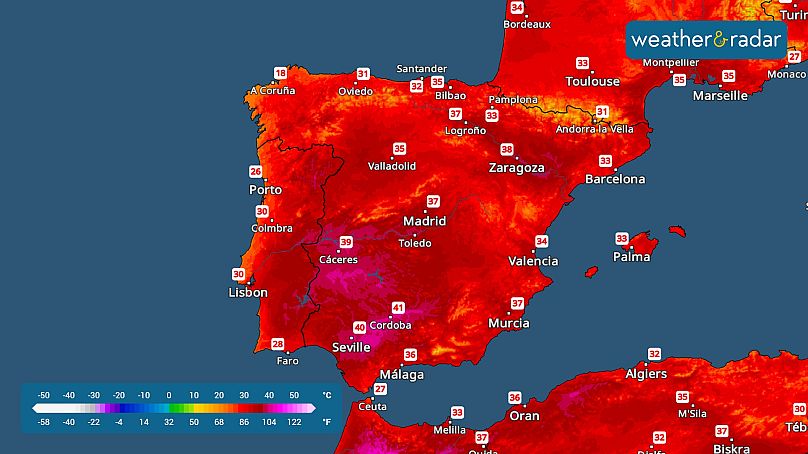
Spain is preparing for an unusually warm summer, hot on the heels of a record-breaking May.
In an update on Friday, national weather agency AEMET said there is a 60 per cent chance the country will be hotter than average from June through to August.
It follows searing temperatures at the end of last month, when the mercury climbed to 40.7C at the airports of Córdoba and Seville, and 37.5C in Zaragoza. Temperatures on 30 May averaged 24.08C - the highest reading for May since records began in 1950.
There is no doubt, as the Intergovernmental Panel on Climate Change (IPCC) has warned before, that “human-caused greenhouse gas emissions have led to an increased frequency and intensity of temperature extremes”.
The last three summers have been Spain’s hottest on record - and summer 2025 looks set to continue that trend.
Where will be the hottest in Spain this summer?
The likelihood of a warmer than usual summer rises to 70 per cent along Spain’s Mediterranean coast and the Balearic and Canary Islands.
The eastern coast - including Barcelona, Valencia, and the Balearics - is expected to experience frequent “tropical nights”, with temperatures failing to drop below 20C, and many consecutive days above 35C.
AEMET has issued several orange‑level warnings for heat today (17 June), including in Córdoba and Seville countryside - where temperatures could hit 41C - and Vegas del Guadiana in Extremadura.
The average June high for Seville and Córdoba is around 33C, Lars Lowinski, a meteorologist at WetterOnline and Weather and Radar, points out.
“While these parts of Spain are used to summer heatwaves, it is part of an increasing trend of hot spells developing earlier during the season while also becoming more intense/longer-lasting, something that can clearly be attributed to climate change,” he tells Euronews Green.

To help people prepare for its increasingly hot summers, last year Spain’s Ministry of Health released a new map with more detailed heat alerts. It breaks the country down from 52 provincial areas into 182 meteosalud (or metro health) zones, providing a colour-based warning system for each.
The hyper-local heat alerts range from Green or no risk through to Red or high risk to health and life. Alongside a colour, these alerts come with information about sun exposure, hydration and symptoms of heat-related illness. There is even an English language version of the official heat alert website, to help alert tourists, students and newly arrived residents to the risk.
This year, Spain’s annual heat plan supplements the new meteosalud areas with a guide advising different administrations, health professionals and citizens when intense heat strikes. It follows a study from the Carlos III Health Institute, which determined the threshold for heatwaves in these different areas, taking into account variables like heat-related deaths.
How is climate change turning up heatwaves?
Every heatwave in the world is now made stronger and more likely to happen because of human-caused climate change, World Weather Attribution (WWA) states.
This is borne out by numerous previous analyses - including one that found extreme heat felt in Spain and Portugal in April 2023 would have been almost impossible without human-caused climate change.
2024 was the warmest year on record and the first calendar year where the global temperature exceeded 1.5°C above pre-industrial levels. Carbon dioxide is the biggest contributor to global warming; its concentration in the atmosphere exceeded 430 parts per million (ppm) last month.
As average temperatures rise, the amount of weather at the ‘extremely hot’ end of the spectrum increases, making extreme heat events more frequent, longer, and more intense.
The heatwave impacting Spain this week is also likely to build into France, the southern UK, parts of Germany and Switzerland, particularly from Saturday, Lowinski says.
Paris could see up to 37C early next week, while 33 or 34C are possible in London.
How to stay safe during a heatwave in Spain
“Extreme heat is a silent killer, affecting people's health, social, environmental, and economic well-being, particularly women and vulnerable communities,” says Kathy Baughman Mcleod, CEO at Climate Resilience for All (CRA).
The women-led climate adaptation NGO shares five points to help people in Spain, Europe and beyond prepare for upcoming brutal heatwaves.
1. Know the signs of heat illness - for yourself and others
Recognise early symptoms like dizziness, headache, nausea, rapid heartbeat, and confusion. Heatstroke is a medical emergency. Watch closely for these in vulnerable groups:
- Pregnant women may experience worsened dehydration and risk to the baby.
- Low-income workers, especially outdoors, may ignore symptoms for fear of losing pay.
- Older adults and children may not feel thirst or express discomfort clearly.
- Co-workers can look fine in one moment, then collapse in the next. Learn to act fast.
2. Use trusted heat early warning systems
Download and follow AEMET for real-time, science-based heat alerts via app, SMS, or website. AEMET issues heatwave warnings by region, severity, and duration - use it to plan your day and check in on others.
3. Everyone's at risk now - even the fit and healthy
With rising temperatures, even healthy adults are suffering from heat exhaustion and heatstroke, especially during physical activity or prolonged exposure.
Don't assume you're immune. Hydrate constantly, rest in the shade or air conditioning and schedule demanding tasks for early morning.
4. Take action to protect your home and community
- Close blinds and shutters during the day.
- Use fans or create cross-ventilation in the evenings.
- Check on neighbours, especially those living alone.
- Advocate for cooling shelters, shaded workspaces, and water access points in your area.
5. Don't underestimate nighttime heat
When nighttime temperatures stay above 25C, the body can't recover from the day's stress. Poor sleep increases heart risk, reduces productivity, and worsens mental health.
- Use cool showers, damp sheets, or ice packs before bed.
- Create a communal "cool room" with fans or AC if electricity is limited.
- Let employers and schools know that heat affects performance and health - even when the sun goes down.







